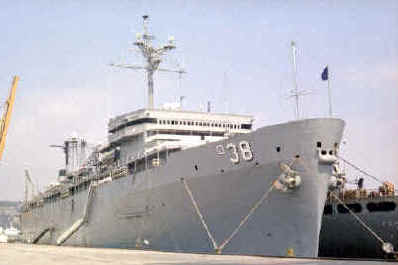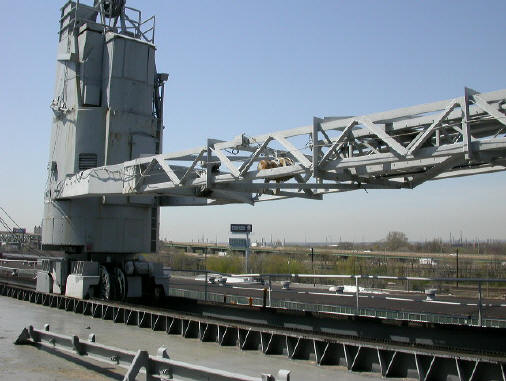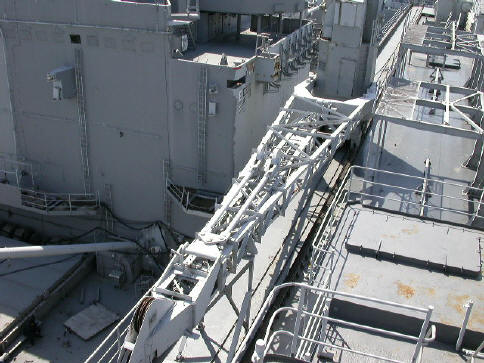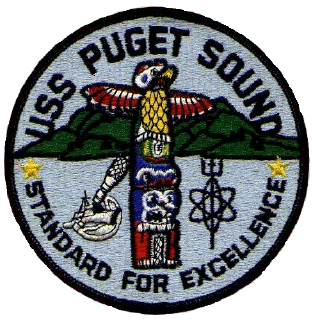|

Bad Day In Newport
By LCDR Mike Snyder, USN (ret)
At the time of this story, LCDR Snyder was
LT (jg)
and the Missile Officer (1973-1974)
U.S.S. PUGET SOUND (AD-38)
 Aboard USS Puget Sound (AD-38), a nuclear capable ship,
the torpedo magazines and ASROC (Anti-Submarine Rocket) magazines extended from
the main deck to 7th deck, just above the voids and tanks and completely across
the width of the ship. The two spaces were mirror images with the torpedo shop
immediately forward of ASROC. A pass through door between the torpedo and ASROC
assembly areas on the 4th deck allowed material to flow from one compartment to
the other. Torpedoes were assembled, tested, and fueled in the torpedo shop then
passed to the Gunners Mates Technicians for building into complete ASROC
missiles. Similarly, had they been aboard, we GMTs could have built and tested a
nuclear depth charge, moved it up one deck up to the ASROC assembly shop and
there continued building it into a complete missile ready for deployment to a
destroyer. The torpedo and ASROC shops shared an ammunition elevator to a main
deck transfer station. There, the outgoing ammunition moved across to a second
elevator which lifted it to the top of the superstructure for craning off into
trucks, boats or to ships alongside.
Aboard USS Puget Sound (AD-38), a nuclear capable ship,
the torpedo magazines and ASROC (Anti-Submarine Rocket) magazines extended from
the main deck to 7th deck, just above the voids and tanks and completely across
the width of the ship. The two spaces were mirror images with the torpedo shop
immediately forward of ASROC. A pass through door between the torpedo and ASROC
assembly areas on the 4th deck allowed material to flow from one compartment to
the other. Torpedoes were assembled, tested, and fueled in the torpedo shop then
passed to the Gunners Mates Technicians for building into complete ASROC
missiles. Similarly, had they been aboard, we GMTs could have built and tested a
nuclear depth charge, moved it up one deck up to the ASROC assembly shop and
there continued building it into a complete missile ready for deployment to a
destroyer. The torpedo and ASROC shops shared an ammunition elevator to a main
deck transfer station. There, the outgoing ammunition moved across to a second
elevator which lifted it to the top of the superstructure for craning off into
trucks, boats or to ships alongside.
 In Newport, Rhode Island the designated ammunition handling days
were Tuesday’s and Thursdays. On those days, nothing else moved on the
two long Navy piers that were always crowded with ships. Two tenders were
routinely present and several cruiser - destroyer squadrons operated from them.
What chaos on ammunition days! Food, fuel, spare parts, mail, people, everything
was held up while weapons were hauled from one ship to another. In some
instances it was but one or two hours, in others it was an all day event. Of
course, all this occurred before the Department of Defense (DOD) and Chief of
Naval Operations staff (OPNAV) ammunition safety review boards put a stop to
handling ammunition in and around inhabited areas. And correctly so. Had there
been a major explosion at one of the piers, many moored ships (often three deep
at the berths), the officers club, department head school, Officers Candidate
School, Destroyer Development Group and a host of offices, including those of
the cruiser / destroyer force commander’s and squadron commander’s, would have
been obliterated.
In Newport, Rhode Island the designated ammunition handling days
were Tuesday’s and Thursdays. On those days, nothing else moved on the
two long Navy piers that were always crowded with ships. Two tenders were
routinely present and several cruiser - destroyer squadrons operated from them.
What chaos on ammunition days! Food, fuel, spare parts, mail, people, everything
was held up while weapons were hauled from one ship to another. In some
instances it was but one or two hours, in others it was an all day event. Of
course, all this occurred before the Department of Defense (DOD) and Chief of
Naval Operations staff (OPNAV) ammunition safety review boards put a stop to
handling ammunition in and around inhabited areas. And correctly so. Had there
been a major explosion at one of the piers, many moored ships (often three deep
at the berths), the officers club, department head school, Officers Candidate
School, Destroyer Development Group and a host of offices, including those of
the cruiser / destroyer force commander’s and squadron commander’s, would have
been obliterated.
On a Tuesday morning Puget Sound
loaded an ASROC missile into a truck and sent it to a destroyer at the
opposite pier. The transfer of several live and training torpedoes closely
followed. All these weapons are relatively light and over-the-side handling was
conducted using single whip from a mobile crane. One crane ran up and down each
side of the ship on rails atop the superstructure where the boats were stowed.
We used four legged slings for ASROC missiles
 in their
containers (commonly called coffins because of their long, domed appearance),
and a single, rubber coated, nylon “belly band” for the torpedoes. I always felt
uneasy with a live torpedo balanced in its belly band 50 feet in the air as it
cleared the side and was lowered into a waiting truck. The handlers did not even
use steadying lines! It looked precarious, but it was the method approved by the
ammo safety folks. in their
containers (commonly called coffins because of their long, domed appearance),
and a single, rubber coated, nylon “belly band” for the torpedoes. I always felt
uneasy with a live torpedo balanced in its belly band 50 feet in the air as it
cleared the side and was lowered into a waiting truck. The handlers did not even
use steadying lines! It looked precarious, but it was the method approved by the
ammo safety folks.
With ammunition movements complete, the piers opened for
regular traffic. People crowded around the after gangway. Milk trucks backed
down the pier, were met by working parties, and unloading through an access in
the side of the ship begun. The repair department, having scheduled the crane,
moved repaired material off the ship into waiting trucks and bar stock and flat
steel back aboard. Messengers from the Commodore, inspection parties, side
cleaners from the deck force, fuel, electricity, and telephone folks, civilian
workers, visitors and families crowded the pier. Looking down from the height of
the boat deck, it appeared as if an ants nest had been stirred.
We secured from the ammunition transfer by sequentially
closing all the doors and hatches from top to bottom, concluding with tidying
the magazines and readying for the noon meal. I was far below in the warhead
magazine when my partner and I heard a loud rumble. The normally solid deck
moved sharply vertical and resonated once or twice before returning to rest. AN
EXPLOSION was my immediate thought! Rushing up to a weather deck we discovered
not a detonation, but something nearly as dramatic and potentially as tragic.
The crane had fallen! The same one we had used to handle ASROC and torpedoes
just a few minutes earlier.
 The boom had free fallen in a tangle of wire, bent steel and deck
equipment. The rivets holding the massive topping lift winches to the crane
structure had carried away. The external shell at the back of the crane
looked like someone had fired a very large caliber machine gun from inside.
Out-dents were everywhere, caused by rivets and other parts flying around inside
the machinery housing,. The operator, riding in a glass enclosure just to the
right side of the boom, remarkably, was uninjured. At the moment of the failure
the crane just happened to be swung inboard so the boom and its elevated load
fell on, and stayed on, the ship. It is terrifying to think that had the failure
occurred less than an hour before a live ASROC or torpedo might have been
involved. Had it occurred only a minute before, the boom, its load and probably
the entire crane with its’ operator, would have crashed onto the pier amidst the
people and vehicles crowded there. Only chance and mere moments separated the
opportunity for death and injury of perhaps hundreds from the catastrophic
mechanical failure.
The boom had free fallen in a tangle of wire, bent steel and deck
equipment. The rivets holding the massive topping lift winches to the crane
structure had carried away. The external shell at the back of the crane
looked like someone had fired a very large caliber machine gun from inside.
Out-dents were everywhere, caused by rivets and other parts flying around inside
the machinery housing,. The operator, riding in a glass enclosure just to the
right side of the boom, remarkably, was uninjured. At the moment of the failure
the crane just happened to be swung inboard so the boom and its elevated load
fell on, and stayed on, the ship. It is terrifying to think that had the failure
occurred less than an hour before a live ASROC or torpedo might have been
involved. Had it occurred only a minute before, the boom, its load and probably
the entire crane with its’ operator, would have crashed onto the pier amidst the
people and vehicles crowded there. Only chance and mere moments separated the
opportunity for death and injury of perhaps hundreds from the catastrophic
mechanical failure.
The sister crane to the one that had fallen
was immediately taken out of service. Neither would return to action in the year
I remained aboard. We came very close to an ammunition accident that day.
The load the crane carried when it failed was relatively light. The failure
could have occurred while live weapons hung in the air. Because of the close
call, I suggested to my department head that we file a nuclear incident report
(Bent Spear). (These are required when there is a failure or accident involving
nuclear weapons support systems, but not a weapon itself.) Others thought
differently and an incident report was not forthcoming. Even now, twenty seven
years later, I shudder at the enormity of the potential accident. I still do not
understand why the ship failed to file the incident report that would have fully
investigated the cause of this calamity.

 

|
